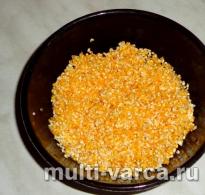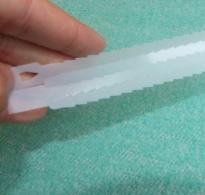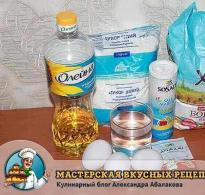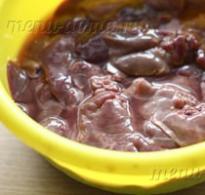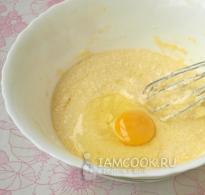How to check the authenticity of red caviar at home. How to distinguish real caviar from a fake at home
Grainy red caviar salmon fish traditionally considered a symbol of a holiday or celebration. Planning to put caviar or dishes with it on the festive table, a person goes to the store to buy red caviar.
In the distribution network, this product can be purchased:
in metal cans;
in glass jars;
by weight.
Here the question immediately arises of how to buy caviar and not spoil the holiday for yourself and your guests. The easiest way to assess the condition and quality of caviar sold by weight.
How to evaluate the quality of loose red caviar
If you are going to buy loose salted salmon caviar, you need to remember that its appearance in the distribution network is associated with the spawning of these fish species. As a rule, it starts in summer and ends in November-December. The most massive catch falls on pink salmon and chum salmon. It is the caviar of them that most often appears on store shelves.
The most fresh caviar pink salmon appears by the end of July. It should be remembered that of all fish products salted caviar has the least resistance to violation of storage conditions. Everyone loves a lightly salted product, but the less salt, the shorter the shelf life, especially if no preservatives were used when salting the caviar.
If you are going to make a purchase, first inspect pink salmon caviar. It should have an orange-red color, its eggs are about the same size. Their average size is 4 mm. Caviar should be grainy and collapsible, that is, the eggs should be easily separated from each other. The number of damaged eggs should be so minimal that they are practically invisible in the total mass of eggs.
Even with preservatives, bulk has a shelf life of no longer than 4 months. If the product was made on August 1, then you can buy pink salmon caviar by weight only until December 1.
Most sellers offer caviar to try. It must be remembered that it is pink salmon caviar that has classic taste. It lacks bitterness, a sharp taste of fish oil. The eggs are easily crushed by the tongue. If the caviar has a sharp smell of fish, is bitter and has an unusual taste, then most likely it was stored in violation of the conditions.
Along with pink salmon caviar, you can also buy chum salmon caviar. In appearance, it is larger in size, its shell is softer and the taste is slightly creamy. Since the chum salmon takes longer to spawn, fresh caviar by weight can be found before the new year.
Somewhat less common is sockeye salmon caviar, it is easy to distinguish it by dark small eggs with a spicy, slightly bitter taste. Even less common loose caviar coho salmon. This fish, like chum salmon, spawns until December itself, and its caviar is hard. It bursts when pressed with the tongue with a characteristic click. Chinook caviar is on sale. It is the largest and tastes like chum. The quality requirements for loose caviar are the same. If the caviar looks too liquid, then most likely it contains much more lopantsev than is allowed, or it is prepared from a thawed product in violation of the technology. If the appearance of loose caviar, its taste and smell are in doubt, then it is better to refuse the purchase.
Buy caviar good quality, hermetically sealed in a glass or metal can somewhat more difficult than evaluating and choosing a weighted salmon caviar.
How to choose high-quality red caviar in jars
It is more convenient to buy red caviar in jars, but it is not easy to evaluate its quality. After all, in the store you can get only indirect confirmation of the quality of caviar from the information posted by the manufacturer on the label. How true it turns out to be, you can only find out at home by opening a jar of caviar.
The jar should indicate from which fish the caviar is obtained. If we are talking about caviar of pink salmon, chum salmon, sockeye salmon, then in one jar there should be only one type of caviar. This information is very important, since, for example, sockeye salmon caviar can be regarded as a fake due to the small size and color of the eggs, or as a spoiled product due to a specific spicy taste.
In addition, the jars should have information about preservatives. In the Russian Federation, preservatives are allowed for use, which are designated E 200, that is, sorbic acid and E 239, that is, urotropin. The content of each substance should not exceed 0.1%.
Also on the jar should be:
manufacturer's address;
product grade;
Date of issue;
best before date.
To evaluate the quality of caviar in a jar, you still have to buy caviar in it, and here you need to be careful.
After all, no matter what the manufacturer marks on the jar, until the consumer opens it, he will not be able to assess the quality of the product. This applies to both glass jars and metal containers.
In an open jar, caviar should look attractive, caviar to caviar should lie. No liquid in the jar is allowed. The eggs should lie one to one, uniform in color, without films and other impurities. Heterogeneity in color is allowed for coho salmon and sockeye caviar.
The taste of the product should be characteristic of the caviar of the indicated type of salmon.
If the smell and taste of caviar indicates that it is spoiled, then you should not risk your health and eat it. When trying to return a defective product to a store, it is important to know that consumer protection law can help.
Back in the 70s of the last century, a jar of black caviar was the main decoration of the festive table in almost any Soviet family. And no one then doubted the quality of the purchased product, and even more so the authenticity. But now this one is for real healthy delicacy costs a lot of money, but the quality does not always correspond to them. In addition, often under the guise of real black caviar, you can buy a fake, and it’s good if it is colored pike caviar, and not gelatinous eggs. In order not to regret the money spent and fully enjoy exquisite taste black caviar, listen to the advice of experts.
Carefully study the packaging
Of course, in terms of hygiene and consumer qualities it is better to buy packaged black caviar. After all, it is not known when loose caviar was produced and discovered, in what conditions it was stored. But you can try it by weight, but you won’t know what will be in the jar until you open it. In order not to buy a fake, you must carefully examine the packaging.
1. Black caviar can be packed in both glass and tin cans. In the markets you can find plastic packaging. Of course, it can also contain a high-quality delicacy, but most likely it is either a fake or a low-quality product.
2. On the factory packaging must be the inscription: "Sturgeon caviar."
3. The label should contain information from what type of fish the caviar is: beluga, sturgeon, stellate sturgeon, sterlet.
4. On the etiquette with real caviar indicate which specifications she was released. It is best to buy one released according to GOST 7442-2002.
5. On a real jar, it is indicated what kind of caviar it is: grained or pressed, pasteurized or not pasteurized.
6. Composition of products. Quality caviar should not contain any additives other than salt.
7. Expiry date can also tell a lot about authenticity. Grain unpasteurized can not be stored for more than two months, and the shelf life of pasteurized does not exceed eight months. The expiration date of the stamp can generally not be more than a month. If the jar has an expiration date of more than 12 months, then this is most likely a fake or preservatives were used in the production.
Very often, large manufacturers indicate how delicious and useful product, downhole or milking. If there is such an inscription on the package, then this is another confirmation of authenticity.
Before buying, carefully look at the marking, it must be made in accordance with Russian standards and include the release date and shift number. When marking sturgeon (letters) and beluga (numbers), the color of the product must be indicated. By the way, if the packaging is glass, then you can easily verify the authenticity by comparing the color and markings.
Sturgeon caviar is marked:
Light shades (light gray, gray, yellow, light brown) - A;
Dark shades (dark gray, brown, dark brown) - B;
Black - W.
Beluga caviar color marking:
Light gray - 000;
Gray - 00;
Dark gray - 0;
Black - H.
When buying caviar packed in a tin, pay attention to how the marking is stamped. If the inscription is convex, then the contents of the jar are genuine, made in accordance with all the rules. If the release date and batch number are concave, then most likely it is a fake. If the marking on the tin is stamped with ink, then this is definitely a fake.
Appearance as an indicator of quality
In order not to buy fake caviar, you should take a closer look at its appearance. Real eggs cannot be perfectly large spherical. If you are offered this fish product, then it is most likely protein. Of course, the size of real caviar depends on the type of fish, but even the largest beluga is several times smaller than artificial. It should also be alerted if all small eggs are the same size, this can only happen with pike, natural black eggs have different sizes.
Genuine, high-quality caviar does not have a pronounced fishy smell. In the manufacture of artificial black caviar, flavors have to be introduced to drown out the taste of gelatin. There should be no deposits on natural high-quality caviar.
Often unscrupulous sellers of loose black caviar in order to betray the product fresh look and shine, handle it vegetable oil. Before buying, rub the caviar with your fingers, if there is an oil trace, then they are treated with oil. When pressed with a spoon, a genuine egg should burst, but if it remains elastic, then it is artificial.
Good quality caviar should be uniform and crumbly. Look at the light through a glass package with caviar - in a genuine jar there should be no suspension, liquid, sticky eggs. If the jar is tilted, the contents should not float. A tin can can be shaken, if squelching sounds are heard, then the caviar is of poor quality or fake.
Some unscrupulous manufacturers mix eggs of different quality in one jar. Waste or spoiled product is usually placed under the top quality layer. To make sure you didn't buy such a sandwich, take a couple of eggs from the bottom of the jar with a small spoon. They should be crumbly and not dry.
Quality control at home
There is one of the simplest and most reliable means to ensure the quality and authenticity of a fish delight. This is ordinary boiled water. Dip a small amount of black eggs into a glass of boiling water and observe. If water:
Dyed black, then you have purchased dyed pike or pollock caviar;
It remained transparent, and an oil film formed on the surface, then this protein film;
I dissolved all the eggs, then they were gelatin balls.
Flakes will float in a glass of boiling water with natural black caviar. It will not dissolve in water, the eggs remain intact, and only swell a little.
In conclusion, I would like to say that you should not buy black caviar produced by unknown producers in dubious places of sale, even if the price is much lower.
6579Festive feast rarely does without red caviar. This is a tasty and healthy delicacy, but only if the product is real. And given the high cost of caviar, it would be a shame to run into a fake. To prevent this from happening, learn to distinguish real caviar from artificial.
1. Consider the jar first, in which caviar is packed. It is better to buy caviar in a glass jar, since such containers are the most neutral in terms of chemical composition, and you can see the caviar in it. Pay attention to the fact that the lid is not swollen. Shake the jar lightly - it should not make gurgling sounds, quality product fills it up very tightly.
2. Look at the markings: the numbers must be pressed in from the inside. Carefully study all the information on the bank. There should be indicated: date of manufacture, expiration date, manufacturer, fish from which caviar was extracted, and composition. You should not buy caviar if at least one component is missing.
3. Date of manufacture must be from May to September, it is during this period that caviar is mined. Pay attention to how the time for caviar production differs from its packaging: if it is several months, then most likely the game has been frozen and has already lost quality. Or is it fake product.

4. If possible, consider caviar. A natural product should be crumbly, elastic and correct form. The eggs are the same in size up to 5-6 mm in diameter. Do not buy too bright or pale caviar. Real caviar should not roll over with the whole mass and stick to the walls, it lies flat in the jar and looks dry, but not dried up.
5. Genuine caviar when lightly pressed bursts in the mouth and does not stick to the teeth. It should not sharply smell like fish, caviar has a pleasant unique aroma. Take a couple of eggs with your hand, if they easily glide over the skin and shine too much, then the caviar is treated with vegetable oil to increase weight and add shine.
6. Buy caviar by weight- the most risky event. Unscrupulous sellers can, for example, add polyphosphates to caviar to increase weight. These are chemicals that retain moisture. Ask the seller for a certificate of quality, which will contain all the information about the delicacy. Pay attention to the cleanliness of the store.

7. Also for mass gain an artificial product obtained from salmon meat is added to caviar by weight. Take a close look at the eggs, if some of them do not contain a kernel, then you have a low-quality delicacy.
8. Caviar processing is done only with the help table salt and freezing or pasteurization. Preservatives are not allowed. Such a product should be stored at a temperature of -18 to -25 degrees for no more than 1 year and 2 months. Also on the jar, the conditions for defrosting caviar should be indicated.
9. After buying caviar, you can check it again at home. Dip a few eggs in boiling water. Real caviar will turn white, and the gelatin fake will immediately dissolve. If you come across a mixed fake product, then you will see that some of the eggs were not real.
10. Real caviar can't be cheap. For example, the retail price of 1 kg of real red caviar is from 18-20 thousand tenge and more.
The New Year holidays are approaching. Each hostess seeks to surprise with some interesting and unusual dish. Frequent guests on the New Year's table, as, in principle, on any festive table- snacks with red caviar. Everyone loves this delicacy, from young to old.
Store shelves are bursting with an abundance of various jars with this red or bright orange delicacy. The price also varies, making the product even more attractive to buy.
Unfortunately, it is not always in a beautiful jar. natural product. Thirst for profit individual people so large that they do not hesitate to fill small containers with various products that resemble caviar in appearance, taste and smell. Good, food industry now abounds various additives. But, unfortunately, this is not all red caviar.
How to pay decent money and leave the store with the treasured delicacy of natural origin?
How to choose caviar in a store
- Try to avoid purchasing goods in plastic containers. For such a solid product, this packaging is clearly not suitable.
- Give preference to glass jars. In them, you can safely see the content, evaluating it by its appearance.
- If the product is in glass jars you don't like it, then consider cans.
The question of how to choose the right caviar is very relevant before new year holidays. Well, it's time to figure it out!
Red caviar is obtained from salmon fish(chum salmon, pink salmon, trout, coho salmon, sockeye salmon). The product is rich in vitamins A, D and E, easily digestible proteins (up to 32% in composition), phosphorus, polyunsaturated fatty acids. Also in the composition: iodine, calcium, potassium and iron, folic acid and other nutrients necessary for immunity, youth and strength. A small amount is enough!
Doctors consider red caviar the most valuable product nutrition. The main thing is to know which red caviar is better to choose and how to recognize a fake. It is very important. After all, instead of royal delicacy you can buy an imitation. For the same money...
So, how to choose high-quality red caviar? We will analyze all the nuances.
We study the information on the packaging
Correct name: Salmon caviar. Classification and characteristics according to GOST 18173-2004.
Granular caviar is made from raw Pacific (Far Eastern) salmon caviar: pink salmon, chum salmon, coho salmon, and sockeye salmon. In production, raw material is processed with a solution of table salt, followed by the addition of preservatives (or without them).
Caviar is of the first and second grade.
Varieties of red caviar
| Index | The norm for the variety | |
| Red caviar 1 grade | Red caviar 2 grade | |
| Appearance | Caviar of one type of fish. The eggs are clean, whole, uniform in color, without films and blood clots. | |
| - a small number of shells (shovel) is allowed | - the presence of shells; | |
| — color heterogeneity; | ||
| - slight sediment. | ||
| Consistency | The eggs are elastic, with a slightly moist or dry surface, they separate well and do not stick. | |
| - may be more moist, slightly less elastic; | ||
| - may be slightly viscous. | ||
| Smell | Peculiar to the product of this type, without foreign odors. | |
| Mass fraction of salt, % | 4 – 6 | 4 – 7 |
| Taste | Peculiar to the product, without foreign aftertaste. A slight aftertaste of bitterness (for sockeye salmon, coho salmon caviar) and pungency is allowed. | |
The composition of red caviar (read on the package)
There should be three rows of signs on the lid:
- date of manufacture;
- assortment mark "IKRA";
- plant number with shift number and fishing industry index "P"
The numbers on a can of high-quality caviar are pressed through from the inside or applied with a laser with indelible paint. Squeezed outside, smeared - a sign of a fake!
- Ingredients: caviar, salt and preservatives. Without them, as a rule, can not do. Allowed use sorbic acid(E200) or sodium benzoate (E211).
- If the composition contains E239 (urotropine), you cannot buy the product - this is a dangerous preservative.
Where and when is caviar packaged?
It is best if the packaging of caviar was carried out near the place of its extraction and production: the Far East, the Russian Federation (Sakhalin, Kamchatka, the Kuriles). According to GOST, no more than a month should pass between the catch and getting into the bank.
- When is caviar packaged?
- Salmon spawning is from July to September. Quality is harvested during these months.
Caviar of pink salmon, chum salmon, coho salmon, sockeye salmon, trout
- Pink salmon caviar. The size of the eggs is 5 mm. Color - from light orange to orange. This caviar is the most common.
- Caviar caviar. The eggs are larger - 5 - 7 mm. Color - amber-orange. The eggs have an even rounded shape, a well-marked speck-embryo. This is the fattest of all types of caviar.
- Salmon caviar. considered the most useful. The size of the eggs is small - about 3 mm. Color is bright orange. The taste has a slightly bitter tint, so this caviar is not the most popular.
- Salmon caviar. Size - 3 - 4 mm. Enough expensive caviar, not often found in Russian market. Color - dark red. There is a pronounced fishy taste.
- Chinook caviar. The eggs are large - 6 - 7 mm. Color is intense red. The taste is specific - bitter, slightly spicy. A very rare product.
- Trout caviar. Small caviar - 2 - 3 mm. Color - from yellow to bright orange. Pronounced salty taste.
Which caviar to choose is up to you. If the product is of good quality, you will not be disappointed in any way.

Signs of good caviar
- Appearance of eggs should be conducive to purchase: they should be even, elastic, without impurities and sediment, should be well separated. Do not stick to the bank and to each other.
- The eye-embryo of the egg must be rich color and stand out.
- The eggs should be elastic, but not springy. The surface is slightly damp. By pressure and in the mouth good caviar breaks easily, does not stick to the teeth.
- The smell should be fishy, moderate. Taste is characteristic this product but not too salty, not bitter. Color - characteristic of red caviar (too pale indicates that the caviar has lost its useful and taste properties).
Signs of a fake
It is equally important to know signs of a fake. Here they are:
- the word "imitated" is present;
- the price is suspiciously low;
- eggs without an eye-embryo, perfectly round and even;
- there is a strong fishy smell, similar to herring milk;
- caviar is very hard and salty, does not burst in the mouth (feeling like chewing gelatin capsules), sticks to the teeth.
Concerning artificial caviar, it cannot be called harmful, but its value for the body is also not great. The product is made from protein, gelatin, milk and eggs. There are no vitamins and useful fatty acids in its composition - it’s definitely not worth buying one at a natural price.

Type of packaging: glass or tin can, by weight, in plastic containers
How to choose a jar of red caviar? What to prefer: tin, plastic, glass?
- The most expensive caviar is usually sold in a glass jar. She looks presentable. But the main thing is that the product can be well considered. Glass is recognized as the best in terms of hygiene - it does not affect the taste.
- Choose red caviar tin cans more difficult - they are not transparent. We will not be able to assess the quality of the product until we open the can. You have to trust the manufacturer. The jar should not be swollen, rusty, mint, all inscriptions should be legible. When shaking, the contents of the jar should not gurgle.
- Caviar by weight, in plastic containers. Such a product can only be purchased from trusted suppliers, good friends. As a rule, there is no data on the composition and expiration date. An unscrupulous seller may apply various additives and even tint the product. plastic containers are the worst packaging - they can be damaged during transportation. Keeping caviar in them is also not very correct.
In a word, tin and glass are a priority.
And finally. Store the product in the refrigerator, respecting the expiration dates. open jar it is better not to keep it for a long time - no more than 5 days. There is also no point in freezing caviar - it will lose not only taste, but also its own characteristics. beneficial features. Appearance will also suffer.
Optimal: bought - ate. Be healthy and happy holidays!

Love sweet tangerines? Learn how to recognize them



